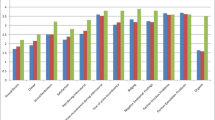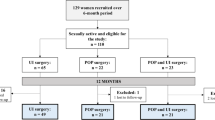Abstract
Introduction and hypothesis
To determine whether fecal incontinence (FI) is associated with sexual activity and to compare sexual function in women with and without FI.
Methods
We conducted a retrospective chart review of all new patients seen in an academic urogynecology clinic. Women who reported fecal incontinence, as defined by loss of fecal material on the Wexner scale, were compared with those without fecal incontinence. We compared sexual activity and Pelvic Organ Prolapse Incontinence Sexual Questionnaire-12 (PISQ-12) scores between groups.
Results
In our population of women with pelvic floor disorder, 588 women reported FI compared with 527 who did not. On multivariate analysis, FI was not associated with sexual activity status, but was associated with worsened PISQ-12 scores (p < 0.001). PISQ-12 item analysis found that women with FI reported more dyspareunia, fear, and avoidance of sexual activity with greater partner problems (all p <0.05) than women without FI.
Conclusions
Women with FI were as likely to engage in sexual relations as women without FI; however, sexually active women with FI had poorer sexual function than those without FI.
Similar content being viewed by others
References
Boreham M, Richter H, Kenton K, Nager C, Gregory WT, Aronson MP, Vogt V, Mcintire D, Schaffer J (2005) Anal incontinence in women presenting for gynecologic care: prevalence, risk factors and impact upon quality of life. Am J Obstet Gynecol 192(5):1637–1642
Perry S, Shaw C, McGrother C, Matthew RJ, Assassa RP, Dallosso H (2002) Prevalence of faecal incontinence in adults aged 40 years or more living in the community. Gut 50:480–484
Johanson JF, Lafferty J (1996) Epidemiology of fecal incontinence: the silent affliction. Am J Gastroenterol 91:33–36
de Mello Portella P, Feldner PC Jr, da Conceição JC, Castro RA, Sartori MG, Girão MJ (2012) Prevalence of and quality of life related to anal incontinence in women with urinary incontinence and pelvic organ prolapse. Eur J Obstet Gynecol Reprod Biol 160(2):228–231
Norton C, Christiansen I, Butler U, Harari D, Nelson RL, Pemberton J (2001–2002) Anal incontinence. In: Abrams P, Cardozo L, Khoury S, Wein A (eds) Incontinence, 2nd edn, International Consultation on Incontinence. Health Publications, Paris
Pretlove SJ, Radley S, Tooz-Hobson PM, Thompson PJ, Coomarasamy A, Khan KS (2006) Prevalence of anal incontinence according to age and gender: a systematic review and meta-regression analysis. Int Urogynecol J Pelvic Floor Dysfunct 17:407–417
Imhoff LR, Brown JS, Creasman JM, Subak LL, Van den Eeden SK, Thom DH, Varma MG, Huang AJ (2012) Fecal incontinence decreases sexual quality of life, but does not prevent sexual activity in women. Dis Colon Rectum 55(10):1059–1065
Riss S, Stift A, Teleky B, Rieder E, Mattlbock M, Maier A, Herbst F (2009) Long-term anorectal and sexual function after overlapping anterior anal sphincter repair: a case-match study. Dis Colon Rectum 52:1095–1100
Trowbridge E, Morgan D, Trowbridge M, Delancey J, Fenner D (2006) Sexual function, quality of life, and severity of anal incontinence after anal sphincteroplasty. Am J Obstet Gynecol 195:1753–1757
Pauls RN, Silva WA, Rooney CM, Siddighi S, Kleeman SA, Dryfhout V, Karram MM (2007) Sexual function following anal sphincteroplasty for fecal incontinence. Am J Obstet Gynecol 197(6):636, e1–6
Rogers RG, Coates KW, Kammerer-Doak D, Khalsa S, Qualls C (2003) A short form of the pelvic organ prolapse/urinary incontinence sexual questionnaire (PISQ-12). Int Urogynecol J Pelvic Floor Dysfunct 14(3):164–168, discussion 168
Barber MD, Walters MD, Bump RC (2005) Short forms of two condition-specific quality-of-life questionnaires for women with pelvic floor disorders (PFDI-20 and PFIQ-7). Am J Obstet Gynecol 193(1):103–113
Sandvik H, Hunskaar S, Seim A, Hermstad R, Vanvik A, Bratt H (1993) Validation of a severity index in female urinary incontinence and its implementation in an epidemiological survey. J Epidemiol Community Health 47:497–499
Bump RC, Mattiasson A, Bø K, Brubaker LP, DeLancey JO, Klarskov P, Shull BL, Smith AR (1996) The standardization of terminology of female pelvic organ prolapse and pelvic floor dysfunction. Am J Obstet Gynecol 175(1):10–17
Aschkenazi SO, Rogers RG, Beaumont J, Botros SM, Sand PK, Goldberg RP (2010) A valid form of the PISQ-12, the PISQ-9, for Use in comparative studies of women with and without pelvic organ prolapse and/or urinary incontinence. Female Pelvic Med Reconstr Surg 16(4):218–223
Patel M, O’Sullivan DM, Steinberg AC (2009) Symptoms of anal incontinence and impact on sexual function. J Reprod Med 54(8):493–498
Edwards NI, Jones D (2001) The prevalence of fecal incontinence in older people living at home. Age Ageing 30(6):503–507
Conflicts of interest
Rebecca G Rogers is DSMB chair for American Medical Systems TRANSFORM trial; none of the other authors has a conflict of interest
Financial support
This study was supported by a pilot grant from the Clinical and Translational Science Center at the University of New Mexico. Supported by the National Center for Research Resources and the National Center for Advancing Translational Sciences through grant number UL1-RR031977.
Author information
Authors and Affiliations
Corresponding author
Rights and permissions
About this article
Cite this article
Cichowski, S.B., Komesu, Y.M., Dunivan, G.C. et al. The association between fecal incontinence and sexual activity and function in women attending a tertiary referral center. Int Urogynecol J 24, 1489–1494 (2013). https://doi.org/10.1007/s00192-013-2044-8
Received:
Accepted:
Published:
Issue Date:
DOI: https://doi.org/10.1007/s00192-013-2044-8




